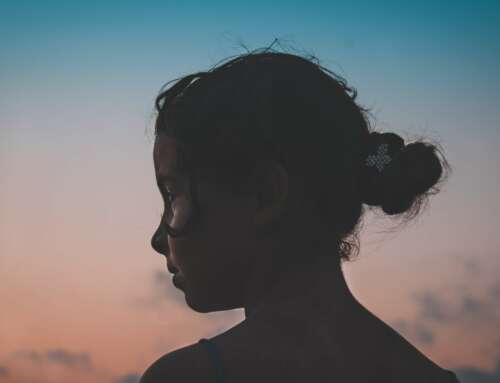When the world is struck with a catastrophic event, the instinct to shield our children from the effects of it is completely understandable. We want them to grow up believing that the world is pure and good and geared in their favour. We also want them to feel safe, and avoiding a discussion isn’t necessarily the way to make this happen.
Older kids and teens will know when something big has happened whether you’re the one who tells them or not. Knowing that something has happened, but not having anybody explain things, is a really scary thing to feel for any of us. Our kids are no different. We all need context and assurance and it’s the facts that will provide this.
All kids are different. They need different information to feel safe, they look for a different level of detail and they are impacted by different parts of the story.
Nobody will know your children better than you do, so it’s important to manage the conversation based on who they are, what they already know, and what it means for them.
With all children.
1. The most important question.
Whatever their age, there is likely to be one thought at the front of their minds, ‘What about me?’ This is normal and healthy and part of the way they process what has happened. They need to understand it in terms of what it means to them and for their own safety and wellbeing. Let this guide your response.
2. Let them know that what they’re feeling makes sense.
We’re all different and will respond to things in different ways. Whether they feel nothing at all or very deeply, let them know that whatever they’re feeling is completely okay. The only way through a feeling is straight through the middle, and this will only happen when there is gentle acceptance of whatever that feeling is. If they see that you can accept what they’re feeling, it will be easier for them to do the same.
3. Name what you see or hear from them.
They need to know that you get it otherwise the things you say will fall short of comforting them. Saying things like, ‘Oh don’t worry,’ or ‘Don’t be silly – nothing like that will happen here,’ though said with the best of intentions, can actually make them worry more. It might also cause them to feel shame which will only make them shut down. They’ll still feel what they’re feeling and think what they’re think but you just won’t find out about it. Whatever they’re feeling, let them know that you get it by reflecting it back to them, ‘I can see you’re feeling scared. That’s completely understandable. It’s a frightening thing to happen.‘
4. And help them to put it in context.
If they’re feeling scared, it will be because they’re noticing the similarities between themselves and the people who have been directly hurt – ages, families, the area they live in – though it might be happening out of their awareness. Explaining the differences between their circumstances and the circumstances around the event will help to ease their fear.
‘This has happened in a different place to where we live. Nothing like this has ever happened here.’ Or if you’re living where the trauma has happened, ‘When something like this happens, people work really hard to make sure that something like this never happens again. The people who do this are really great at what they do. They learn a lot about how it happened and the type of people who did it and they use that information to keep everyone safe.’
5, Ask directly what it is they’re worried about.
Trauma triggers all sorts of things in all of us. Sometimes these will directly relate to the event: How will they look after the people who have been hurt? Have they caught the bad guys? How did it happen? Could it happen here? Sometimes, it might be more indirect and unexpected. They might become scared of you dying or getting sick. They might worry about not being able to reach you when they need to, or of something happening while they are asleep or separated from you. Let them know that when something big happens, we can feel all kinds of things that don’t make sense but there are no silly feelings or silly things to think. Ask them what they’re thinking and give them permission to say anything they want to.
6. Be available.
Let them know that they can come to you with questions, feelings, ideas and thoughts and that nothing is off-limits. Give them extra cuddles or an extra story. For older ones, spend extra time sitting on the edge of their bed at bedtime. They might raise things with you or they might not, but at least you’re there if they need to.
7. Let them see your compassion, empathy, and resilience.
It’s okay to let them know that you are sad for the people who have been hurt – this will nurture their empathy and compassion – but they also need to see your strength and capacity to cope with the news.
8. It’s okay not to have the answers they’re asking for.
Frightening world events don’t make sense to any of us. Your children might ask questions that you don’t know the answers to, such as ‘How did it happen?’ or ‘Why do some people do awful things?’ In these cases, ‘I don’t know,’ is a perfectly reasonable answer. Sometimes it’s the only one.
9. Remind them of the goodness in the world.
They need to have faith in the world and the people in it. Whenever there is trauma in the world, there are also remarkable demonstrations of solidarity and kindness, love and support for strangers. Let them hear these stories. We belong to a humanity that is good and kind. People who orchestrate traumatic events are acting against humanity, they’re not a part of it and when they strike, humanity always proves to be kinder, more generous, and stronger. Remind them.
10. Let them feel the arms of the world around them, too.
Let them know that when something like this happens, the world comes together to look after each other and that people from all over the world are working to make the world safer for them.
Being proactive in having the conversation with kids can ensure that you’re the one who sets the emotional tone for what has happened – not their friends, not social media and not the 6pm news. Show them that you have faith in their world and their ability to thrive in it.
– Karen Young, Hey Sigmund
Read more: How to talk to kids and teens about world trauma
Image source: Flickr







Leave A Comment